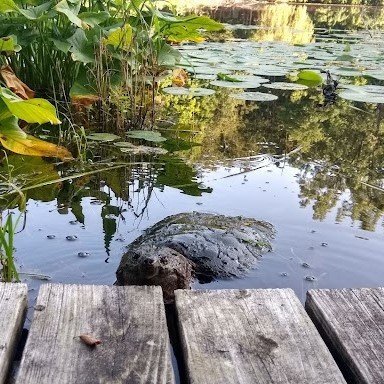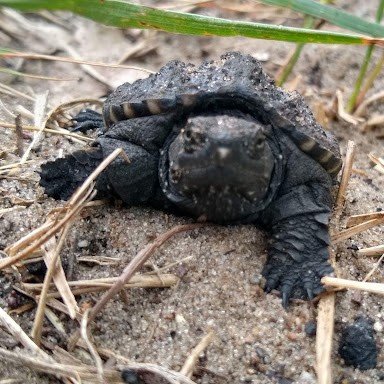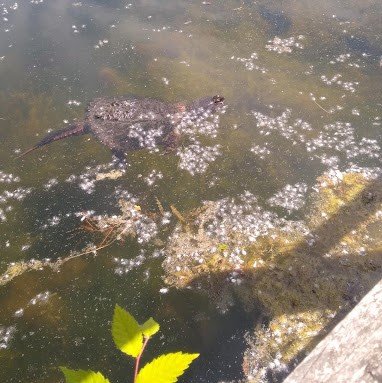Creature Feature: Make It Snappy
One of my favorite summer-active animals that are often viewable at the Johnson Nature Center are turtles. Ten different species can be found within the state of Michigan, and each have their own characteristics and design that makes them unique. The common map turtle, for example, has a shell that reminds us of topography, while the painted turtle shows off streaks and splotches of red, orange, and yellow. My favorite turtle of the lot is the one that looks the most prehistoric, and at first glance could easily be mistaken for an alligator, or baby Godzilla.
This is, of course, the common snapping turtle. So what makes them so cool? Like many turtle species, the common snapping turtle can live for a long time. If left undisturbed in the wild, the general consensus is that it has the potential to live between 30 and 45 years. In captivity, they can exceed these numbers due to less stresses that would normally be found in their environment. Spending most of its time submerged underwater as opposed to basking in the sun, the snapping turtle is more likely to use its beak-like jaws when outside of the water, where it becomes more vulnerable and is unable to swim away from threats. When we think of a snapping turtle, it is easy to assume that their diet is strictly meat and other animals. However, these turtles are actually omnivorous, with a large part of their diet being aquatic plants in addition to animals such as frogs and fish.
While these turtles can be found from the Atlantic coast to the Rocky Mountains, they also have a southern cousin called the alligator snapping turtle. The difference between the two? Besides being bigger, the alligator snapping turtle displays scales in the form of three jagged ridges on its carapace (the top side of its shell) that, when floating on the surface, can make them truly appear like an alligator. But fear not, they have a smaller range than their more common cousins. Mostly centered in the Lower Mississippi river basin with states such as Illinois being its northernmost range.
It may be intimidating to be in the presence of a turtle that seemingly has an immensely powerful jaw, but this may not necessarily be the case. The common snapping turtle has a bite force of approximately 210 newtons while the alligator snapping turtle has even less, measuring in at over 150 newtons (see Herrel et al., 2002). A newton is a unit of measure for the amount of required force, and force is calculated by taking the mass of an object, and multiplying its rate of speed, or acceleration. For further context, a human’s bite force in newtons can be measured in the several hundreds. Woo, physics!
Despite having a weaker bite force than humans, caution must still be exercised when in close proximity or handling snapping turtles. Since the snapping turtle's jaw is shaped in the form of a beak, it can take its force and focus its pressure on just one particular area. That, combined with a sharp beak, can have the potential to cause serious injury. Granted, incidents involving snapping turtles of either species is rare, but it is still ill-advised to provoke them, especially when it is out of the water.
Here’s a neat final fact: recent studies suggest that snapping turtles can sense the magnetic fields of the earth, which it could depend on for movement, and orienteering (see Landler et al., 2015).
I think that covers the bulk of it! Before you go, please enjoy this snapping turtle gallery that, in my opinion, makes them look quite photogenic.
From left to right: Donatello, Leonardo, Michelangelo, and Raphael
Click here to learn more about the common snapping turtle
References and Further Readings:
Herrel, A., O’Reilly, J. C., & Richmond, A. M. (2002). Evolution of bite performance in turtles. Journal of Evolutionary Biology, 15(6), 1083-1094. https://doi.org/10.1046/j.1420-9101.2002.00459.x
Landler, L., Painter, M. S., Youmans, P. W., Hopkins, W. A., & Phillips, J. B. (2015). Spontaneous magnetic alignment by yearling snapping turtles: rapid association of radio frequency dependent pattern of magnetic input with novel surroundings. PloS one, 10(5), e0124728. https://doi.org/10.1371/journal.pone.0124728
Submitted by Zach Mork, Naturalist, July 2022




